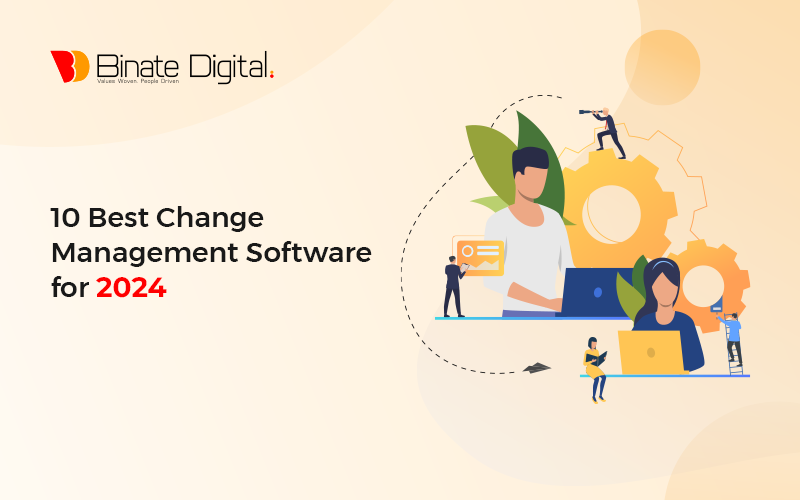It might be difficult to choose the best change management for you when there are so many options available. You need to choose the right software so that you can efficiently plan, execute, and monitor changes to your business’s systems and procedures. In this blog, we will discuss this in detail so it will make your decision easier in this place by sharing my personal experiences utilizing hundreds of different change management software in a range of industries.
On this Article
What Is Change Management Software?
Change management software specifies specialized tools and apps created to advance and modernize the procedure of managing organizational change. These software solutions are developed to help businesses plan, implement, and track changes effectively. These software solutions serve as an initiated platform, beneficence a systematic approach to plan, execute, and display changes within an association. They typically embrace features such as project planning to extract the steps and timelines for change programs, dialog tools for collaboration and streamlining, workflow computerization to streamline methods, and document management to incorporate relevant documentation. Additionally, change management software frequently includes risk assessment efficiencies, performance analysis for examining the impact of changes, and training support to provide employees with the necessary expertise. By using this software, organizations can boost their power to adjust to progressing circumstances, enhance employee engagement, and expand the overall success proportion of change initiatives.
ManageEngine ServiceDesk Plus
ManageEngine ServiceDesk Plus is an inclusive IT service management (ITSM) software that provides a range of components, which include change management. It is created to streamline and automate diverse factors of IT service delivery. The change management function within ServiceDesk Plus concentrates on efficiently handling changes within a company’s IT framework. With ManageEngine ServiceDesk Plus, organizations can strategize, implement, and track changes thoroughly. The software expedites the development of regulated workflows for change requests, guaranteeing that changes are determined, approved, and equipped in a controlled manner. It also offers features for impact analytics, risk estimation, and documentation, allowing organizations to reduce disruptions and maintain the integrity of IT services during transitions. ServiceDesk Plus integrates change management with other ITSM procedures, such as incident management and problem management, building an organized approach to managing IT services. The software is known for its user-friendly link, automation abilities, and reporting software, making it a popular choice for IT teams looking to increase their change management forms within a broader IT service management structure.
Jira Service Management
Jira Service Management, part of the Atlassian suite, includes change management performance to support organizations in managing and analyzing changes effectively. With its combination with Jira Software, it supports an impeccable experience for development and IT teams. Jira Service Management’s cooperation features and adaptable workflows provide successful change executions for organizations through industries.
Prosci Change Management
Prosci is a distinguished change management software that supports a complete approach, offering software for planning, development, and aid of organizational changes. It incorporates research-based methodologies and robust analytics to enhance the success of change initiatives. Prosci facilitates effective communication, collaboration, and measurement, making it a preferred choice for organizations aiming for seamless transitions.
ChangeGear by SunView
ChangeGear stands out as a comprehensive IT service management platform that includes change management functionalities. This software streamlines the change process with features such as automated workflows, impact analysis, and risk assessment. ChangeGear enables teams to collaborate efficiently, ensuring that changes are implemented easily while minimizing disruptions to business operations.
ServiceNow
ServiceNow’s Change Management unit is part of its wider IT Service Management (ITSM) suite. It contributes to a centralized platform for planning, organizing, and tracking changes. With automation capabilities, ServiceNow ensures consistent and standardized change processes. Its real-time reporting and analytics contribute to informed decision-making, making it a valuable tool for organizations undergoing transformation.
IBM Maximo
IBM Maximo is an asset management software that includes robust change management features. It helps organizations plan and control changes to assets, reducing downtime and operational risks. With features like impact analysis and comprehensive reporting, IBM Maximo supports organizations in maintaining a clear view of their assets and the changes affecting them.
BMC Helix ITSM
BMC Helix ITSM integrates change management into its broader IT service management suite. It identifies collaboration, computerization, and compliance to ensure efficient change methods. The software’s inherent interface and resilient features make it a dependable choice for organizations looking to enhance their change management ways and improve complete IT service delivery.
Change.com
Change.com is a cloud-based change management platform that concentrates on user-friendly features. It allows software for planning, monitoring, and analyzing changes while upgrading collaboration among team representatives. Change.com is particularly appropriate for small to medium-sized businesses desiring effective change management solutions with its importance on simplicity and availability.
Ivanti Service Manager
Ivanti Service Manager blends IT service management with change management proficiencies. It modernized the change procedures with automation, guaranteeing that changes are measured, approved, and implemented seamlessly. The software’s intuitive interface and integration capabilities contribute to improved efficiency and collaboration among IT teams.
Cherwell Service Management
Cherwell’s Service Management platform includes resilient change management features to reinforce companies in planning and executing changes effectively. Cherwell authorizes organizations to adjust to progressing circumstances while nurturing a clear view of their change enterprises with workflow automation, adaptable methods, and concurrent reporting.
Freshservice
Freshservice, an ITSM tool, includes change management functionalities that center on explaining the change methods. Freshservice allows organizations to conduct changes proficiently with features like change templates, automated workflows, and an intuitive connection. It caters to various industries, making it flexible to diverse organizational needs.
How I Decided Which Change Management Tools Were Best
Here’s where I break down my selection process for the finest change management solutions, in case you were wondering. I began by using change management software, which has a high rating for satisfaction and customer reviews. Then, by applying my project management expertise, I was able to identify the most crucial requirements for change management software and evaluate how each one stood up to the others. I understand how long it can take to find suitable software for a task. I take care of this, so you don’t have to worry, here are a few guidelines for you:
Selection Standards
These, in my opinion, are the most crucial factors to take into account when choosing the finest change management software. This is a quick summary of the why and what’s behind my choice.
User Interface (UI): The usability, uptake, and efficacy of change management tools can all be greatly impacted by their UI, which makes it an essential consideration when selecting these solutions. Organizations can increase their total capacity for change management and expedite their change management procedures with the use of an intuitive and user-friendly user interface (UI).
Usability: Let’s avoid adding to the already difficult task of change management. The ease of learning and efficient use of a tool by its users is referred to as its usability. A change management tool’s usability can cause users to get frustrated and confused, which lowers the tool’s overall efficacy and user adoption rates. On the other hand, companies can improve productivity, decrease errors, and streamline their change management procedures with the aid of a very user-friendly change management solution.
Integrations: Software integrations are crucial for choosing change management tools since they facilitate smooth system-to-system communication and task automation. Numerous systems and technologies, including project management software, customer relationship management (CRM) software, and collaborative platforms, may be used in the implementation of change management efforts. The change process is streamlined when these tools are integrated with change management software.
Pricing: Since pricing has a big dominance on the funds allowed for change management projects, it is important to consider it when choosing change management technologies. A tool’s price should be determined in relation to its features, flexibility, usability, and expected return on investment. Businesses should choose a product that suits their financial limits and brings the required effectiveness at a fair cost.
Why Nearshore Software Development Is Important For A Company
For businesses seeking effective and cooperative solutions, nearshore software development is crucial. First and foremost, being close geographically is essential for promoting efficient communication, cutting down on latency, and facilitating real-time customer and development team cooperation. This synergy is further enhanced by time zone alignment, which guarantees that teams may operate synchronously without experiencing major delays. Another important factor is cultural affinity, which makes it easier to share a common understanding of corporate procedures, improving teamwork and lowering the risk of miscommunication. Furthermore, by addressing particular technology demands, nearshore development enables businesses to access a wide range of talent and specialized skills available in neighboring nations. Ultimately, lower travel expenses and the opportunity for regular on-site visits help customers and their nearshore software development partners build stronger bonds and a deeper understanding of one another, which promotes fruitful and profitable long-term collaborations.
Building The Future With Remote Development Team
Embrace the flexibility that remote work offers while maintaining a focus on productivity and innovation. Building the future with a remote development team involves leveraging technology and fostering effective collaboration to achieve shared goals. It requires clear communication channels, collaboration tools, and a strong team culture. Emphasizing transparent project management, defining roles and responsibilities, and fostering a sense of connection among team members are crucial for successRegular virtual meetings, well-defined tasks, and adapting to evolving circumstances contribute to a dynamic and thriving remote development environment.
The Future Trends Of IT Staff Augmentation Services
Enhanced Remote Cooperation
With IT staff augmentation services developing to facilitate smooth cooperation across dispersed teams through sophisticated communication and collaboration capabilities, the trend of remote work is probably here to stay.
Emphasis On Cybersecurity Knowledge
The need for IT staff augmentation services, which support adept cybersecurity experts to enhance a company’s security posture, will grow as long as cybersecurity oppression continues to appear.
Ascent Of Specialized Fields
IT staff augmentation services will probably witness an increase in specialist specializations that cater to particular technologies or industries because more companies are looking for highly specialized talents to handle their particular difficulties.
AI And Automation Integration
As IT staff augmentation services become more complex, there will be more utilization of AI and automation to modernize repetitive activities and free up experts to work on more strategic and challenging projects.
Blockchain Knowledge
As blockchain technology becomes more widely used, there may be a rise in the need for IT staff augmentation services from experts in blockchain creation, installation, and upkeep.
Emphasis On Soft Skills
As remote work and different team structures become the norm in IT staff augmentation, there will be a greater emphasis on soft skills like adaptation, communication, and teamwork in addition to technical talents.
Global Talent Pools
Businesses will keep using these resources to find the best candidates, wherever they may be in the world. This will result in a more diversified and scattered workforce for IT staff augmentation.
Data Science And Analytics
The need for IT staff augmentation services that provide professionals in data science, analysis, and business intelligence will expand due to the growing impact of analytical decision-making.
Upskilling And Continuous Learning
IT professionals and staff augmentation providers must place a high priority on upskilling and continuous learning to keep up with the swiftly changing technology and business curves.
Adaptability of Advancement And Digitalization
Pricing is an important standard for testing features, usability, flexibility, and expected ROI. Selecting a tool that aligns with budgetary constraints while providing essential functionality ensures a cost-effective and sustainable approach to change management. The effectiveness of organizational transitions is largely dependent on the ability to monitor progress, control risks, and maintain transparency. Investing in strong change management software becomes a strategic asset rather than merely a tool for accomplishing effective and long-lasting change projects as firms deal with growing complexity and the demand for agility. The future trends of IT staff augmentation services are poised to shape a dynamic landscape driven by technological advancements, changing work dynamics, and evolving industry needs. The continued rise of remote collaboration, coupled with a focus on cybersecurity expertise and niche specializations, reflects the adaptability of these services to meet the complex demands of the digital era.
Conclusion
In conclusion, effective change management software should balance a user-friendly interface, high benefits, seamless blendings, and affordable pricing to meet the various needs of organizations undergoing evolving methods. Careful consideration of these criteria ensures that the selected software aligns with organizational goals and maximizes the success of change management initiatives. Change management software is essential to an organization’s ability to navigate and implement changes successfully. Throughout the change process, it offers a defined framework, promotes communication, and allows stakeholders to work together. When choosing change management software, consider key criteria such as user interface (UI), usability, integrations, and pricing. An intuitive UI streamlines processes increases user satisfaction, and reduces errors. Integrations increase efficiency by computerizing tasks and fostering coherent communication between systems.







